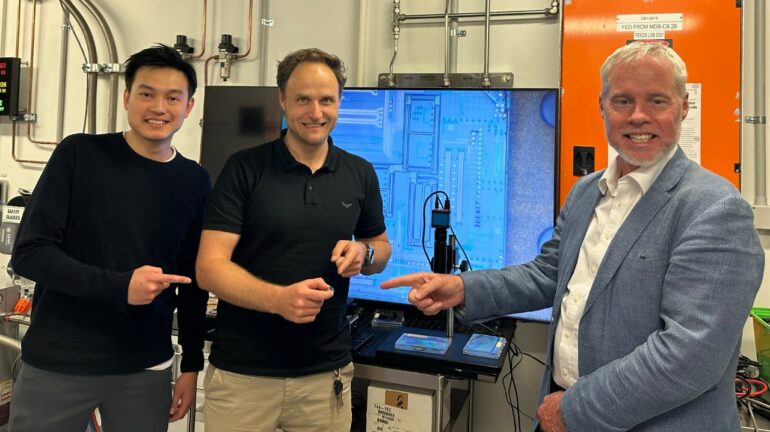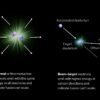A team of researchers has for the first time successfully used lasers to generate guided sound waves on the surface of a microchip. These acoustic waves, akin to the surface waves produced during an earthquake, travel across the chip at frequencies nearly a billion times higher than those found in earth tremors.
By containing the sound wave on the surface of a chip, it can more easily interact with the environment, making it a perfect candidate for advanced sensing technologies.
The findings are published in APL Photonics.
“The use of sound waves on the surface of a microchip has applications in sensing, signal processing and advanced communications technology,” said senior author and project lead Dr. Moritz Merklein from the University of Sydney Nano Institute and School of Physics. “We can now start to think about new designs for chips that use light and sound instead of electricity.
Lead author Govert Neijts, a student from the University of Twente in the Netherlands who spent nine months at the University of Sydney labs, said, “Typically, surface acoustic waves are ‘excited’ using electronics. Here we use photonics, or light energy, to produce the sound wave. This approach has multiple advantages, chief of which is that light does not produce the heat in the chip that electronic excitation causes.”
Using special glass made from germanium, arsenic and selenide known as GeAsSe, the scientists were able to achieve remarkable results, including measurements indicating strong interactions between light and sound.
This innovative research demonstrates how lasers can be used to create and detect high-frequency surface acoustic waves using novel materials as a “wave guide.”
“The material is considered a soft glass. This means that, unlike many materials, it operates as a guide for the high-frequency sound waves and lets them more freely interact with the light waves we put into the chip,” Dr. Merklein said.
The ability to generate and manipulate these high-frequency acoustic waves opens a world of possibilities for new applications in sensing and signal processing.
Co-author Dr. Choon-Kong Lai, a postdoctoral researcher in the Institute of Photonics and Optical Science at the University of Sydney, said, “Imagine sensors that can detect minute changes in the environment or advanced signal processing techniques that enhance communication technologies.
“Our innovative approach not only paves the way for more sensitive and efficient devices but also expands the potential for integrating acoustic and optical technologies on a single chip.”
The team previously demonstrated “capturing” light information inside phononics, or sound waves within a chip. This “lightning inside thunder” innovation was a world first at the time.
“We have developed this work to be able to manage and guide high-frequency sound wave information on the surface of a chip. This is an important contribution for the development of emergent sensing technologies,” said co-author and research team leader, Professor Ben Eggleton, Pro-Vice-Chancellor (Research) at the University of Sydney.
The technique used by the researchers is known as stimulated Brillouin scattering (SBS). This is created by an enhanced feedback loop between photons (light) and phonons (sound).
As light moves around the chip or an optical fiber, it creates sound vibrations. Previously seen as a nuisance in optical communication, scientists then realized they could couple and enhance this vibration as a new way to transport and process information.
The feedback process allows light waves (usually produced by lasers) and sound waves to “couple,” enhancing the power of this feedback effect. Researchers expect applications of stimulated Brillouin scattering to have applications in 5G/6G and broadband networks, sensors, satellite communication, radar systems, defense systems and even radio astronomy.
More information:
Govert Neijts et al, On-chip stimulated Brillouin scattering via surface acoustic waves, APL Photonics (2024). DOI: 10.1063/5.0220496
Provided by
University of Sydney
Citation:
New microchip design harnesses sound waves on the surface for advanced sensing technologies (2024, October 23)



